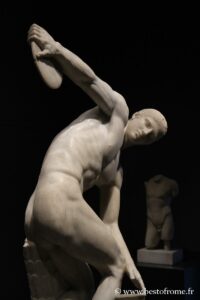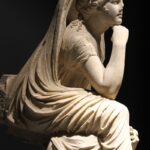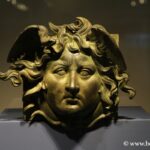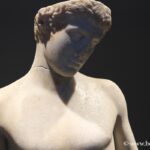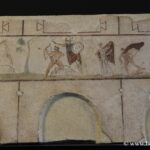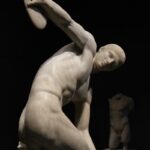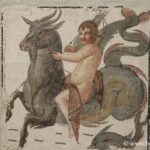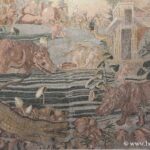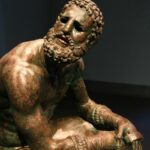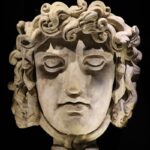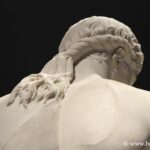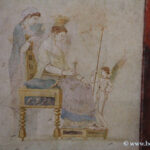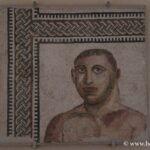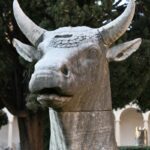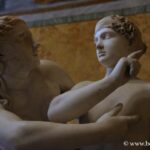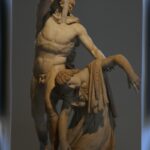In italian : Museo Nazionale Romano
Home to the largest archaeological collection in the world, the National Roman Museum is distributed over four sites, the most important of which is the Palazzo Massimo alle Terme, the others being the Baths of Diocletian, the Palazzo Altemps and the Balbi Crypt.
It is highly recommended if ancient art interests you, to at least visit the Palazzo Massimo alle Terme, where one discovers Greco-Roman masterpieces of sculpture, and especially wonderful reconstructed rooms of Roman houses with their original frescoes, or exceptional mosaic floors.
Palazzo Massimo alle Terme
This 19th-century palace, in neo-16th-century style, includes several prestigious and historical collections.
The section of Victor Emmanuel III of Savoy gathers the goldsmith, jewels and precious stones, often funerary.
On the ground floor and first floor are sculptures, reliefs, busts, dated between the end of the Republican era and the beginning of the empire, of Greek-Hellenistic art. Among the masterpieces are the Augustus as Pontiff Maximo, the Maiden of Anzio, Roman copies of Greeks including the famous Discobolus Lancellotti, the sleeping Hermaphroditus, etc. A section devoted to bronze works includes elements of the ships of Nemi.
On the second floor are reconstructed rooms of Roman villas with their original frescoes and mosaics. These are emblematic examples of Roman decorative art, luxurious and elegant, including the rooms of the Villa of Livia, the Farnesina Villa, mosaics of Republican period pavements, in black and white, polychrome, or more complex of the imperial era.
In the basement is preserved the largest numismatic collection in Italy, which belonged to King Victor Emmanuel III of Savoy, retaining unique pieces.
Baths of Diocletian
The Baths of Diocletian are also home to many works, including sarcophagi, steles and a vast epigraphic section, as well as a section on prehistory and the peoples of the region.
Part of the museum is dedicated to the prehistoric peoples of the region of Rome and Italy.
In one of the ancient halls of the baths, a family tomb and a columbarium were installed.
The design of its large cloister is attributed to Michelangelo.
Altemps Palace
The Altemps Palace (Palazzo Altemps) houses important ancient sculptures that come from the collections of great families such as the Ludovisi, Altemps and Mattei.
Among the famous sculptures: Ludovisi Throne, the Ludovisi Battle sarcophagus, the Ludovisi Gaul, the Ludovisi Ares, the Ludovisi Dionysus, the Juno Ludovisi, etc.
Balbi Crypt
The Balbi Crypt, the smallest of the four sites, preserves a medieval collection. Its interest consists above all in highlighting the archaeological strata of Rome on the very site of the crypt.
Photo Gallery
- Seated Goddess, Palazzo Massimo
- Bronzes of Lake Nemi, Palazzo Massimo
- Marble statue, Palazzo Massimo
- Columbarium of the Villa Pamphilj, Palazzo Massimo
- Discobolus, Palazzo Massimo
- Mosaic, Via Cassia, Palazzo Massimo
- Mosaic of imperial villa, Palazzo Massimo
- Basilica of Giugno Basso, Palazzo Massimo,
- Boxer, Palazzo Massimo
- Sculpture, Palazzo Massimo
- Statue of Apollo, Palazzo Massimo
- Marble statue, Palazzo Massimo
- Villa Farnesina, Palazzo Massimo
- Mosaics, Baths of Diocletian
- Bull’s head, baths of Diocletian,
- Julius Caesar, Palazzo Altemps
- Sculpture, Palazzo Altemps
- Suicide of the Galate, Altemps Palace
- Balbi Crypt
Informations, visits and tours
Museo Nazionale Romano
Via E. de Nicola, 79
www.museonazionaleromano.beniculturali.it
Palazzo Massimo alle Terme : Largo di Villa Peretti, Roma
Terme di Diocleziano : Viale Enrico De Nicola 79, Roma
Palazzo Altemps : Piazza di Sant’Apollinare 46, Roma
Cripte Baldi : Via delle Botteghe Oscure 31, Roma
- Hours: Open every day from 9 am to 7:45 pm. Closed on Mondays (except Easter Monday and during Culture Week). Closed on January 1st and December 25th.
The ticket office closes at 6:45 pm. - Ticket and fare: Full combined fare (valid 3 days): €12, reduced fare: €8
Full price one site: 8 €, reduced price: 2 €
In case of exposure, prices are increased
MNR Card, unlimited access to all four sites for one year: €25, reduced rate: €15
Guided tours
Links
- Official website : museonazionaleromano.beniculturali.it
- Wikipedia page : en.wikipedia.org
Map
If you see this after your page is loaded completely, leafletJS files are missing.








